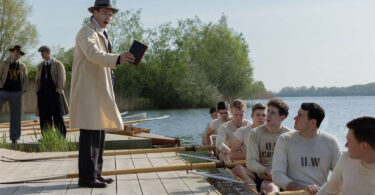Robbie Breitweiser
Fall marks the beginning of beach camping season for me. Summer excursions can be fun, especially for swimming, but the midday sun gets hot if you can’t find or create some shade. The wind might drop to nothing in the morning and leave you flapping and spitting in a cloud of no-see-ums, which are probably my least favorite insect. And I’ll never shrug off a coastal thunderstorm again after trying to crouch on one foot in my tent on Bear Island around 4 a.m. in July, hoping that would help me avoid electrocution.
Granted, common sense and weather forecasts can help prevent such situations. And most camping areas at the North Carolina coast are pretty civilized affairs anyway, with designated, drive-up campsites, toilets, running water, and other basic amenities. Summer isn’t so rough if you can pitch a tent twenty feet from your car and freshen up with a cool shower.
The other kind of camping is less widely available at our beaches: “primitive” camping, where there are no designated sites and you just find a good spot and have at it, is only allowed, to my knowledge, within the Cape Lookout National Seashore (CLNS). The north-south component runs forty-odd miles from Portsmouth Island, south of the Ocracoke Inlet, through the North and South Core Banks, terminating at Cape Lookout with its diamond-patterned lighthouse.
Primitive camping is permitted here, but the islands are somewhat low, narrow and monotonous, due to the prevailing winds running parallel to the beach rather than across it. Also, 4WD vehicles are allowed on the Core Banks, so a well-meaning fisherman can roll up and spoil one’s Robinson Crusoe trip with little warning.
Being prone to Robinson Crusoe trips, my go-to spot for primitive beach camping is the third island of the CLNS: Shackleford Banks. Running roughly east-west for 8.5 miles, Shackleford is about a mile wide and sits across the Back Sound from Beaufort and Harkers Island in mainland Carteret County.
It was connected to Cape Lookout until a 1933 hurricane opened Barden Inlet and severed it from Core Banks. It has high, sandy dunes on its west (Beaufort) end and lower, rockier features on its east (Harkers Island) end, with large tracts of maritime forest and open, grassy areas throughout.
Uninhabited since 1902, Shackleford Banks remains a beautiful and diverse island, despite sporadic trash washed up by the ocean or left behind by inconsiderate visitors. Built up by cross-island wind currents, it boasts a whopping 281 plant species, plus various animals from mice, rabbits and raccoons to the occasional deer (I’ve seen one) as well as reptiles and of course a wide variety of birds. Crabs and other standard beach critters abound, and in cooler weather it’s easy to spot pods of dolphins cruising along the shore.
Without a doubt, Shackleford is best known for its 120 or so wild horses, supposedly jettisoned from foundering Spanish galleons hundreds of years ago. Scattered around the island in family groups or “harems” of varying size, the horses might be my favorite feature of Shackleford Banks, but I won’t go into detail about them here, as a wealth of information on the subject is available elsewhere. Suffice to say that both the horses and the island itself are public treasures that demand respect and stewardship of all visitors, and feeding, approaching or otherwise hassling the horses is illegal and wrong.
Apart from a no-frills restroom on its west end and a dilapidated gazebo towards the middle, there are no structures or roads on Shackleford. No vehicles are allowed, though one may occasionally see an ATV on “official business.” There is no running water so you literally have to carry everything you need with you when you go, and pack out any trash. The island is accessible only by private boat or one of two passenger ferries operated by Island Express Ferry Service. These depart from Beaufort (to the west end) and Harkers Island (to the east end and Cape Lookout) throughout the year, and cost $20. Most folks visit for a few hours and don’t venture too far from their arrival point, but Island Express takes campers as well.
A reservation generally isn’t necessary, but adverse weather (especially lightning or high winds) can cause ferry cancellations, so it’s crucial to watch the forecast and check by phone if possible. The Beaufort ferry has a longer and more exposed route and is canceled more frequently.
Taking a gear-laden cart might seem sensible but dragging it around gets old quickly, especially if you want to go any distance. Rather than camp on either end of the island, I prefer to backpack a few miles towards its center where, particularly in the off-season, you can easily not see another soul all day. So shedding weight is key: I pack a tent, sleeping bag, two quarts of water, a little food, basic camping accessories, maybe binoculars or a kite if the wind is up, and lastly a small aluminum shovel for digging “catholes” (if you don’t know you’ll figure it out).
I usually find a spot with short, horse-nibbled grass behind the dune line and pitch my tent there rather than on the sand.
Then there’s nothing to do but enjoy the place: roaming Shackleford’s beaches and interior, staring out to sea, and gawking at the stars when they come out. Cooler weather makes camping on Shackleford perfect and I can’t wait to get back out there.








